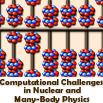Speakers
Hugo Adrian Ortega
Jason Holt
Description
Jason Holt
Nuclear forces and exotic nuclei.
Within the context of valence-space Hamiltonians derived
from different ab initio many-body methods, I will discuss
the importance of 3N forces in understanding and making new
discoveries in two of the most exciting regions of the
nuclear chart: exotic oxygen and calcium isotopes. Beginning
in oxygen, we find that the effects of 3N forces are
decisive in explaining why 24O is the last bound oxygen
isotope [1,2].
Furthermore, 3N forces play a key role in reproducing
spectra, including signatures of doubly magic 22,24O, as
well as properties of isotopes beyond the dripline. The
calcium isotopes, with potentially three new magic numbers
beyond the standard N=20,28, present a unique laboratory to
study the evolution of shell structure in medium-mass
nuclei. From the viewpoint of two-neutron separation
energies and spectroscopic signatures of doubly-magic
systems, I emphasize the impact of 3N forces in reproducing
the N=28 magic number in 48Ca and in predicting properties
of 50-56Ca, which indicate new N=32,34 magic numbers.
Finally, I will highlight new efforts to quantify theoretical
uncertainties in ab initio calculations of medium-mass
nuclei by exploring resolution-scale dependence of
observables in sd-shell isotopic/isotonic chains.
---------------------------------------------------------------------
Adrian Ortega
Eigenvalue and eigenvector statistics for bosonic embedded
gaussian ensembles
Within the framework in Random Matrix Theory (RMT), there
exists the Bosonic Embedded Gaussian Ensembles. In the last
few years, there has been a renewed interest in such
ensembles. These ensembles display different eigenvalue and
eigenvector correlations compared against the canonical
ensembles of RMT. I shall describe briefly these bosonic
ensembles when the single-particle states are two. Novel
results will be presented for three single-particle states.
In this framework, I shall describe also some numerical
experiments on a variation of the Bose-Hubbard model, namely
the Random Bose-Hubbard model. Another ongoing interesting
project is the study of quantum dynamics in disordered
networks, and the roles that play the particle correlations
that benefits the transition probability between two
ocupation-number states.

